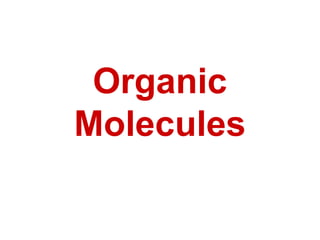Organic compound folable
•Transferir como PPT, PDF•
3 gostaram•1,613 visualizações
Remake of foldable #2
Denunciar
Compartilhar
Denunciar
Compartilhar

Recomendados
Recomendados
Mais conteúdo relacionado
Mais procurados
Mais procurados (19)
Destaque (6)
Shapes And Bond Angles Of Simple Organic Compounds

Shapes And Bond Angles Of Simple Organic Compounds
Semelhante a Organic compound folable
Semelhante a Organic compound folable (20)
Carbon Chemistry and Applications - Gurumurthy B R

Carbon Chemistry and Applications - Gurumurthy B R
Organic chemistry review for Anatomy and Physiology Students

Organic chemistry review for Anatomy and Physiology Students
The Chemical Basis for Life---ORGANIC COMPOUNDS (1).pptx

The Chemical Basis for Life---ORGANIC COMPOUNDS (1).pptx
Último
This presentation was provided by William Mattingly of the Smithsonian Institution, during the third segment of the NISO training series "AI & Prompt Design." Session Three: Beginning Conversations, was held on April 18, 2024.Mattingly "AI & Prompt Design: The Basics of Prompt Design"

Mattingly "AI & Prompt Design: The Basics of Prompt Design"National Information Standards Organization (NISO)
This presentation was provided by William Mattingly of the Smithsonian Institution, during the fourth segment of the NISO training series "AI & Prompt Design." Session Four: Structured Data and Assistants, was held on April 25, 2024.Mattingly "AI & Prompt Design: Structured Data, Assistants, & RAG"

Mattingly "AI & Prompt Design: Structured Data, Assistants, & RAG"National Information Standards Organization (NISO)
Último (20)
9548086042 for call girls in Indira Nagar with room service

9548086042 for call girls in Indira Nagar with room service
Mattingly "AI & Prompt Design: The Basics of Prompt Design"

Mattingly "AI & Prompt Design: The Basics of Prompt Design"
Call Girls in Dwarka Mor Delhi Contact Us 9654467111

Call Girls in Dwarka Mor Delhi Contact Us 9654467111
Z Score,T Score, Percential Rank and Box Plot Graph

Z Score,T Score, Percential Rank and Box Plot Graph
Mattingly "AI & Prompt Design: Structured Data, Assistants, & RAG"

Mattingly "AI & Prompt Design: Structured Data, Assistants, & RAG"
Russian Escort Service in Delhi 11k Hotel Foreigner Russian Call Girls in Delhi

Russian Escort Service in Delhi 11k Hotel Foreigner Russian Call Girls in Delhi
Ecosystem Interactions Class Discussion Presentation in Blue Green Lined Styl...

Ecosystem Interactions Class Discussion Presentation in Blue Green Lined Styl...
Beyond the EU: DORA and NIS 2 Directive's Global Impact

Beyond the EU: DORA and NIS 2 Directive's Global Impact
Measures of Dispersion and Variability: Range, QD, AD and SD

Measures of Dispersion and Variability: Range, QD, AD and SD
Organic compound folable
- 2. 4 Groups of Organic Compounds Found in Living Things • “Organic” Compounds – Organic means “contains Carbon”
- 3. Carbon Molecules Carbon-based molecules have three basic structures Straight Chain Branched Chain Ring All structures based on carbon's ability to form four covalent bonds
- 4. • “Biomolecules” = large organic compounds – Built by bonding small molecules (monomers) together to form chains called “polymers” – Formed by a chemical reaction called “condensation”
- 5. Condensation H OH H20 H20 H20 “lysis” = split apart HOW TO BUILD A LARGER MOLECULE BY COMBINING SMALLER MOLECULES. HOW TO BREAK DOWN A LARGER MOLECULE INTO SMALLER MOLECULES. Hydrolysis
- 6. • ISOMER = Compounds with the same chemical formula, but different 3D structure Chemical formula C6H1206 = glucose C6H1206 = fructose 3D Structure O OH OH HO OH CH2OH O HOCH2 OH OH OH CH2OH
- 7. CARBOHYDRATES • Made up of C, H, & O • Main source of energy • Used for structural purposes in plants (cellulose)
- 8. CARBOHYDRATES • SIMPLEST = single sugar molecules = “monosaccharide” – Example: glucose, fructose glucose Monosaccharide fructose Monosaccharide Disaccharide sucrose H20 Think of each monosaccharide as a lego piece. A disaccharide is made up of two monosaccharides
- 9. CARBOHYDRATES • LARGEST = “polysaccharide” – Example: starch, fiber, cellulose, glycogen Polysaccharide A polysaccharide is made up of many monosaccharides.
- 10. Lipids • Aka “fats” • Made up of mostly C & H • Ex: fats, oils, waxes, steroids • Used to store energy (insulation, too) • Part of the cell membrane and waterproof covering • ALL are INSOLUBLE in water because they are NON POLAR
- 11. Most fats in our bodies and foods are in the form of 'triglyceride' molecules = one glycerol (or glycerin, a sugar alcohol) + three fatty acids attached Lipids
- 12. Lipids 2 Long chain of CH is called “fatty acid chain” Example: lard = maximum # of H+ atoms Example: olive oil = at least 1 C = C (carbon-carbon double bond) = more than one C = C (carbon-carbon double bond) Example: cooking oil
- 14. Nucleic Acids • They contain C, H, O, N, P • Nucleic Acids = polymers (made up of nucleotides) nucleotide nucleotide nucleotide N N N “Nucleic Acid” monomermonomer
- 15. Nucleic Acids • 3 parts of a nucleotide A) 5 carbon sugar (pentose) B) Phosphate group C) Nitrogenous base
- 16. Nucleic Acids • Store and transmit genetic info • 2 types – DNA sugar = deoxyribose – RNA sugar = ribose
- 17. Proteins • Contain C, H, O, N and some S • Basic building block = Amino acid (AA) • Peptide bonds hold molecules (AA) together Peptide bond
- 18. Proteins • 3 parts of an amino acid – amino acid (-NH2) – carboxyl group (-COOH) – R group (always different) • Hydrogen bonds fold amino acid into specific shapes for function
- 19. Protein • Each protein has a specific role – Control rate of reaction – Regulate cell processes – Form bones and muscles – Transport substances in/out of cell • Example: “enzymes” = “proteins” that change rate of reaction, increase pH and temperature